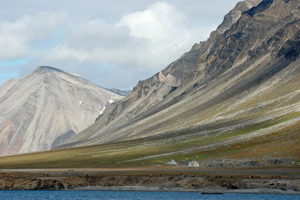Vårsolbukta
[77° 45.3' N 14° 20' E]
By Øystein Overrein (ed.), Jørn Henriksen, Bjørn Fossli Johansen, Kristin Prestvold
The biggest attraction in the bay Vårsolbukta is the little auk cliff. In addition there is lush moss tundra on which the Svalbard reindeer love to graze – the tundra is richly fertilized by hundreds of thousands of little auks. As elsewhere in Bellsund, you can find cultural remains from the Neo-Industrial era in Vårsolbukta.
Take care:
- Check the tide – it can be difficult navigating with small boats in the tidal waves in Akselsundet.
- At nesting geese locations no landings are allowed until nesting and moulting are over, and in any case not before 1 August.
- The cultural remains shall not be removed, damaged or destroyed.
- Around cultural remains there is a safety zone of 100 m within which it is not allowed to pitch tents or light campfires.
- Look out for sunken rocks close to shore.
- Wet moss tundra – minimize treading – tracks will stay permanently.
- Do not disturb the little auks in the scree slope.
 In 1917 there was a whalebone avenue and portal at Camp Bell in Vårsolbukta. (Image: Adolf Hoel / The Norwegian Polar Institute) In 1917 there was a whalebone avenue and portal at Camp Bell in Vårsolbukta. (Image: Adolf Hoel / The Norwegian Polar Institute)
 Tourists on the shore by Camp Millar in Vårsolbukta. In the background you can see the scree slopes of Ingeborgfjellet where the little auks nest. (Image: Jørn Henriksen) Tourists on the shore by Camp Millar in Vårsolbukta. In the background you can see the scree slopes of Ingeborgfjellet where the little auks nest. (Image: Jørn Henriksen)
Vårsolbukta takes its name from the cutter Vaarsol from Tromsø. The vessel was used by the Norwegian Svalbard Expedition in 1914. The name – spring sun – also happens to be descriptive of this place. Geese arrive in early spring to start nesting or to stop and graze before flying further north in Svalbard or across to north-east Greenland. Murky water with sunken rocks and large foreshores characterize the coast here. Vårsolbukta is part of the 50 km long and in some places 10 km wide strandflat that stretches all the way north to Kapp Linné, at the entrance of Isfjorden.
At Ingeborgfjellet, just north of Camp Millar, there is a large colony of little auks. The birds nest in the scree slope, which further down is covered with moss tundra. The moss tundra is thickest below the highest densities of little auks.
In addition to the birdlife there are good chances of seeing Svalbard reindeer in Vårsolbukta.
History and cultural remains
There are three houses in Vårsolbukta, all easily visible from the sea. They are all connected to the history of the Northern Exploration Company (NEC). In 1906, the British prospector and later the leader of the NEC, Ernest Mansfield, occupied all of Bellsund. The annexations also included the areas around Van Mijenfjorden, Van Keulenfjorden, Recherchefjorden and Braganzavågen. One of the NEC houses in Vårsolbukta is Camp Bell. The building was erected as a base for prospecting gold and platinum in the summer of 1908 and Mansfield overwintered in the house from 1908-1909. In 1910 Mansfield built two houses directly east of Camp Bell and called it Camp Millar. The entrance to the stoll (horizontal mine) that was made to prospect for gold is situated about 150 m from the coast at Millarodden.
The houses that the NEC erected in Vårsolbukta are identical to the houses they erected at Ny-London (at that time simply called London) in Kongsfjorden. The houses in Vårsolbukta are located in a beautiful landscape near a large bird cliff, Ingeborgfjellet. The Governor of Svalbard keeps the houses in good repair. In danger of falling into the sea, Camp Bell has been moved away from the edge to a safer location.
Mansfield owned a coalmine by Kolfjellet, on the northern shores of the entrance of Van Mijenfjorden, and erected some buildings there. The installation was called Camp Morton. The story goes that before Mansfield’s occupations, the merchant Ivar Stenehjem got funding in 1901 for a couple of expeditions to Spitsbergen with the help of ship-owner Christian Michelsen from Bergen. Michelsen later became Norway’s first prime minister in 1905. At Camp Morton, Stenehjem built a large timber building called Michelsenhuset, which is still standing today. The same expedition erected what is now the oldest building in Calypsobyen, west of Recherchefjorden.
The mines and buildings that Ernest Mansfield and the NEC established in Svalbard were markers to maintain control of their claims, safeguarding them against competitors that passed through the area in search of minerals.
Vulnerable elementsNesting geese fly off the nest when they are scared, leaving the eggs and chicks exposed to predators such as Arctic fox and glaucous gull. If you see signs of fox dens you should keep a good distance to the opening. The little auks in the scree slope are easily accessible. If people walk into the colony in the nesting season, they might damage nests situated in between the rocks. The moss tundra is also vulnerable to being walked on. Landing sitesLandings in Vårsolbukta are not easy. Look out for sunken rocks. The best landing place is not in Vårsolbukta itself, but at the pebble beach in the bay directly east of Vårsolbukta. The strong tidal rip in Akselsundet may make it both difficult and risky to operate small boats in the area. Embarking and disembarking from the larger vessel could also be difficult. Recommended trailsBe careful not to disturb the geese. If you want to walk towards the foot of Ingeborgfjellet, choose a route that minimizes treading on the vulnerable moss tundra. The best trail west toward Camp Bell and Camp Millar is along the coast.
|